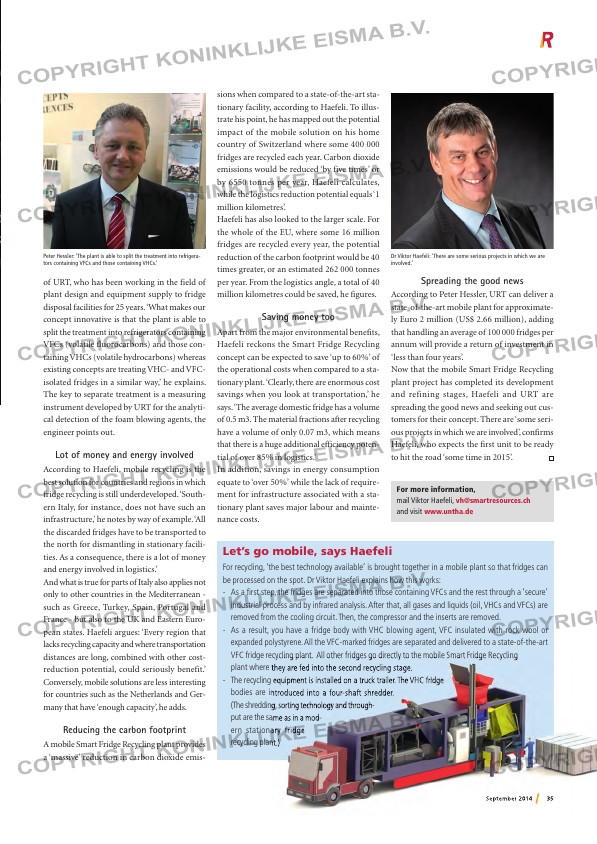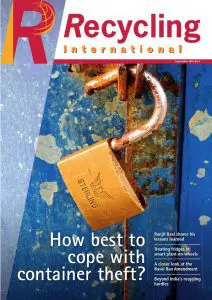Page 35 from: September 2014

35September 2014
of URT, who has been working in the field of
plant design and equipment supply to fridge
disposal facilities for 25 years. ‘What makes our
concept innovative is that the plant is able to
split the treatment into refrigerators containing
VFCs (volatile fluorocarbons) and those con-
taining VHCs (volatile hydrocarbons) whereas
existing concepts are treating VHC- and VFC-
isolated fridges in a similar way,’ he explains.
The key to separate treatment is a measuring
instrument developed by URT for the analyti-
cal detection of the foam blowing agents, the
engineer points out.
Lot of money and energy involved
According to Haefeli, mobile recycling is the
best solution for countries and regions in which
fridge recycling is still underdeveloped. ‘South-
ern Italy, for instance, does not have such an
infrastructure,’ he notes by way of example. ‘All
the discarded fridges have to be transported to
the north for dismantling in stationary facili-
ties. As a consequence, there is a lot of money
and energy involved in logistics.’
And what is true for parts of Italy also applies not
only to other countries in the Mediterranean –
such as Greece, Turkey, Spain, Portugal and
France – but also to the UK and Eastern Euro-
pean states. Haefeli argues: ‘Every region that
lacks recycling capacity and where transportation
distances are long, combined with other cost-
reduction potential, could seriously benefit.’
Conversely, mobile solutions are less interesting
for countries such as the Netherlands and Ger-
many that have ‘enough capacity’, he adds.
Reducing the carbon footprint
A mobile Smart Fridge Recycling plant provides
a ‘massive’ reduction in carbon dioxide emis-
sions when compared to a state-of-the-art sta-
tionary facility, according to Haefeli. To illus-
trate his point, he has mapped out the potential
impact of the mobile solution on his home
country of Switzerland where some 400 000
fridges are recycled each year. Carbon dioxide
emissions would be reduced ‘by five times’ or
by 6550 tonnes per year, Haefeli calculates,
while the logistics reduction potential equals ‘1
million kilometres’.
Haefeli has also looked to the larger scale. For
the whole of the EU, where some 16 million
fridges are recycled every year, the potential
reduction of the carbon footprint would be 40
times greater, or an estimated 262 000 tonnes
per year. From the logistics angle, a total of 40
million kilometres could be saved, he figures.
Saving money too
Apart from the major environmental benefits,
Haefeli reckons the Smart Fridge Recycling
concept can be expected to save ‘up to 60%’ of
the operational costs when compared to a sta-
tionary plant. ‘Clearly, there are enormous cost
savings when you look at transportation,’ he
says. ‘The average domestic fridge has a volume
of 0.5 m3. The material fractions after recycling
have a volume of only 0.07 m3, which means
that there is a huge additional efficiency poten-
tial of over 85% in logistics.’
In addition, savings in energy consumption
equate to ‘over 50%’ while the lack of require-
ment for infrastructure associated with a sta-
tionary plant saves major labour and mainte-
nance costs.
Spreading the good news
According to Peter Hessler, URT can deliver a
state-of-the-art mobile plant for approximate-
ly Euro 2 million (US$ 2.66 million), adding
that handling an average of 100 000 fridges per
annum will provide a return of investment in
‘less than four years’.
Now that the mobile Smart Fridge Recycling
plant project has completed its development
and refining stages, Haefeli and URT are
spreading the good news and seeking out cus-
tomers for their concept. There are ‘some seri-
ous projects in which we are involved’, confirms
Haefeli, who expects the first unit to be ready
to hit the road ‘some time in 2015’.
Let’s go mobile, says Haefeli
For recycling, ‘the best technology available’ is brought together in a mobile plant so that fridges can
be processed on the spot. Dr Viktor Haefeli explains how this works:
– As a fi rst step, the fridges are separated into those containing VFCs and the rest through a ‘secure’
industrial process and by infrared analysis. After that, all gases and liquids (oil, VHCs and VFCs) are
removed from the cooling circuit. Then, the compressor and the inserts are removed.
– As a result, you have a fridge body with VHC blowing agent, VFC insulated with rock wool or
expanded polystyrene. All the VFC-marked fridges are separated and delivered to a state-of-the-art
VFC fridge recycling plant. All other fridges go directly to the mobile Smart Fridge Recycling
plant where they are fed into the second recycling stage.
– The recycling equipment is installed on a truck trailer. The VHC fridge
bodies are introduced into a four-shaft shredder.
(The shredding, sorting technology and through-
put are the same as in a mod-
ern stationary fridge
recycling plant.)
For more information,
mail Viktor Haefeli, [email protected]
and visit www.untha.de
Dr Viktor Haefeli: ‘There are some serious projects in which we are
involved.’
Peter Hessler: ‘The plant is able to split the treatment into refrigera-
tors containing VFCs and those containing VHCs.’
Smart response to
a logistical nightmare
RI-7 Fridge recycling.indd 35 01-09-14 09:18



